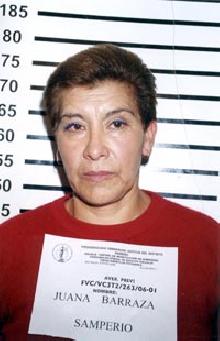| Juana Barraza | ||
|---|---|---|
| short summary | ||
| Birth name | Juana Barraza | |
| Also known as | Mataviejitas (Sp. "Old Lady Killer")La Dama del Silencio (Sp. The Silent Lady) | |
| Born | 1956 (age 54–55) | |
| Killings | ||
| Number of victims | 11+ | |
| Span of killings | Late 1990s–January 25, 2006 | |
| Country | Mexico | |
| State(s) |
| |
| Date apprehended | January 25, 2006 | |

Juana Barraza: AKA "Mataviejitas" ("Old Lady Killer");
Juana Barraza (born 1956) is a Mexican professional wrestler and dubbed a serial killer La Mataviejitas (Sp. "The Old Lady Killer") sentenced to 759 years in jail for killing eleven elderly women. The first murder attributed to Mataviejitas has been dated variously to the late 1990s and to a specific killing on 17 November 2003. The authorities and the press have given various estimates as to the total number of the killer's victims, with estimated totals ranging from 24 to 49 deaths.
Background
Juana Barraza was born in Hidalgo, a rural area north of Mexico City Barraza's mother was an alcoholic who reportedly exchanged her for three beers to a man who constantly and repeatedly raped her while in his care, and by whom she became pregnant and gave birth to a boy. In total she had four children , although her eldest son died from injuries sustained in a mugging. Prior to her arrest, Barraza was a professional wrestler under the stage name La Dama del Silencio (The Silent Lady). She had an obsession with lucha libre a form of Mexican masked professional wrestling in which the wrestlers engage in titanic mock battles.
Profile
All of Barraza's victims were women aged 60 or over, most of whom lived alone. She bludgeoned or strangled her victims, and afterward would rob them. Police reported that there was evidence of abuse in a number of cases
Bernardo Bátiz,the chief prosecutor in Mexico City,initially profiled the killer as having "a brilliant mind, [being] quite clever and careful", and probably struck after a period spent gaining the trust of an intended victim. Officers investigating suspected that she posed as a government official offering the chance to sign up to welfare program.
The search for Barraza was complicated by conflicting evidence. At one point, the police hypothesized that two killers might be involved. Then an odd coincidence distracted the investigation; at least three of Barraza's victims owned a print of an 18th century painting by the French artist Jean-Baptiste Greuze, Boy in red waistcoat.
Investigation
The authorities were heavily criticised by the media for dismissing
evidence that a serial killer was at work in Mexico City as merely
"media sensationalism" as late as the summer of 2005. Soon after setting
an investigation in motion, the police incurred further criticism by
launching what one journalist described as a "ham-fisted" and
unproductive swoop on Mexico City's transvestite prostitutes.
By November 2005, the Mexican authorities were reporting witness statements to the effect that the killer wore women's clothing to gain access to the victim's apartments. In one case a large woman in a red blouse was seen leaving the home of a murdered woman. Two months later, police began checking the fingerprints of bodies in the city's morgues in the apparent belief that Mataviejitas might have committed suicide.
A major breakthrough in the case occurred on 25 January 2006, when a suspect was arrested fleeing from the home of the serial killer's latest victim, Ana María de los Reyes Alfaro, who lived in the Venistiano Carranza (one of the 16 boroughs of mexico's federal districts within the borough of Mexico City. Alfaro, 82, had been strangled with a stethoscope.
To the surprise of many Mexicans, who had supposed the killer to be male, the suspect detained was Juana Barraza, 48, a female wrestler known professionally as The Silent Lady. Witnesses at previous murder scenes had described a masculine-looking woman and police had previously looked for a transvestite although they later admitted that the former wrestler resembled composite images of the suspect. Barraza closely resembled a model of the killer's features, which showed La Mataviejitas with close-cropped hair dyed blonde and a facial mole, and was carrying a stethoscope, pension forms and a card identifying her as a social worker when she was detained.
Mexico City prosecutors said fingerprint evidence linked Barraza to at least 10 murders of the as many as 40 murders attributed to the killer. The wrestler is said to have confessed to murdering Alfaro and three other women, but denied involvement in all other killings. She told reporters she had visited Alfaro's home in search of laundry work.
Trial and verdict
Barraza was tried in the spring of 2008, the prosecution alleging she had been responsible for as many as 40 deaths. She admitted one murder, that of Alfaro, and told the police her motive was lingering resentment regarding her own mother's treatment of her. On 31 March she was found guilty on 16 charges of murder and aggravated burglary, including 11 separate counts of murder. She was sentenced to 759 years in prison. Since sentences imposed in Mexican courts are generally served concurrently, however, she will be eligible for parole after serving a maximum of 50 years.
Documentaries
Barraza was highlighted in the documentary "Instinto Asesino" which aired on Discovery en Espanol in 2010. The episode was entitled, "la Mataviejitas". Juana Barraza was also highlighted on the show La Historia Detras Del Mito the episode was entitled La Mataviejitas.